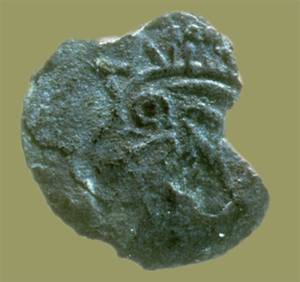A Medieval Coin in New England Soil September 11, 2010
Author: Beach Combing | in : Medieval , trackback After much interest in the long-travelling Helgö Buddha Beachcombing is pleased to introduce a more controversial wrong-place piece, an eleventh-century Viking coin that allegedly ended up in New England’s soil several generations before Columbus.
After much interest in the long-travelling Helgö Buddha Beachcombing is pleased to introduce a more controversial wrong-place piece, an eleventh-century Viking coin that allegedly ended up in New England’s soil several generations before Columbus.
The Maine Penny, as it called, was found by an ‘amateur’ (an ugly word for archaeologists) at the Goddard site near the mouth of Penobscot Bay on 18 August 1956. It was identified as an English (sic) silver coin. And it was only in late 1978 that it was correctly identified as a silver Norwegian piece dating to the reign of Olaf the Peaceful (1067–1093).
It is universally accepted that the Goddard site was occupied by Indians in the twelfth and thirteenth centuries and many thousands of items were excavated there. This was an Indian trading hub on the Atlantic Coast.
The discovery of a Viking penny in New England would be remarkable, exciting and worth playing the bagpipes over. But it would not challenge too many historical or archaeological orthodoxies. True no Viking coins have yet been found north or west of Iceland. But there is no question that Vikings settled in Newfoundland in the early eleventh century. And even if this settlement was short-lived, Viking settlements in Greenland continued up until the early fifteenth century. A couple of coins might have found their way over…
There is not even the need to create a ‘Vinland’ on Rhode Island or, indeed, a Florida-bound Viking merchant. The coin, could easily have turned up in one of the Viking settlements and then have been traded southwards through Indian intermediaries. Beachcombing should note here that several indigenous objects from the far north arrived at Goddard having followed just that route towards the Equator.
So why the scepticism?
Well, the coin was found by one Guy Mellegren who excavated Goddard and who was, as Beachcombing mentioned above, an ‘amateur’. His notes, for example, were described by a professional as ‘hopelessly sketchy’. (13)
Mellegren had though another far more disgusting secret lurking in his background. He had – the horror! – Swedish ancestry on his father’s side… This is not Beachcombing’s Vikophobia making itself felt. The problem is that Scandinavian Americans have often been, in misplaced acts of ethnic’ pride, behind pre-Columbian Viking ‘finds’ in the New World: e.g. the Kensington Stone.
Beachcombing cannot help wondering how many modern New Englanders have some Scandinavian ancestry, but he can also see why a bit of Viking blood might set off alarm bells among archaeologists. And, as with all anomalous finds, the question remains: did Mellegren plant the coin or have it planted on him?
Edward Carpenter, a researcher and sceptic – in fine Scotch style he refers to the find as ‘non-proven’ – has made much of the fact that Mellegren was relatively silent about his dramatic find over many years. But this seems to be elucidated by Mellegren himself in a 1969 lecture where Mellegren remembered the discovery of an ‘English’ coin. He had three explanations for this curiosity: (i) lost at Goddard in the Middle Ages, (ii) handed down through colonial times and lost there; or (iii) brought from abroad and lost at Goddard at a later date [8].
Only the first would have been worth opening the champagne over and Mellegren considered that the third ‘was the most likely’ – Beachcombing points the good reader to mad and bad Walt Halliday for an example of such finds or, rather, ‘losses’.
It was only when the coin was later identified as Viking that the game heated up. By then poor Mellegren – who, Beachcombing must say was someone with a reputation for integrity – had passed away.
Beachcombing has no illusions about much of the nonsense written about pre-Columbian visits to North America. But in this case he would give a thumb and a half followed by two cheers and three quarters. There is a good chance that this really is what it seems: a European coin that found its way to North America in the twelfth century. Minted in Norway, spent in Iceland, gambled in Greenland, traded in Newfoundland, carried to Goddard where it fell through a hole in a brave’s pocket.
Beachcombing loves far-flung coin finds: please do write in with any others, drbeachcombing AT yahoo DOT com
***
26 Sept 2011: Thanks to BB for possible Norse origins for Two Northeastern United States Cat Populations Remarkable Stuff!


